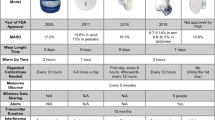Abstract
An existing algorithm designed to control d-tubocurarine-induced muscle relaxation in humans has been evaluated in 38 clinical trials on patients undergoing upper and lower abdominal surgery. The data captured during these trials were used to perform offline analysis of the algorithm reported on here, by which the correct functioning of the algorthm was established and its efficacy rated. It is shown that, for practical purposes, the average controller performance is close to the theoretical limit which can be achieved for this drug. The use of online parameter estimation makes precise initialisation of the controller less critical than would be the case with a fixed control low. In the trials undertaken, an average time of 12 min was needed to reach the chosen set point and excessive overshoot was avoided in every case. With a setpoint for the single twitch response of 20 per cent of the control height, the average drug consumption for the first hour of operation was 0·38 mg kg−1.
Similar content being viewed by others
References
Bevan, D. R. (1983) Neuromuscular blocking drugs.Can. Anaesth. Soc. J.,30, 556–561.
Bradlow, H. S. andRametti, L. B. (1982) A model for use in automated control of muscle relaxation during surgical procedures. Sixth IFAC Symposium on Identification and System Parameter Estimation, Washington, June 1982.
Bradlow, H. S., Sherlock, B. G., Thornington, R. E. andSolomon, E. S. (1983) Model determination for use in automated control of drug dosages: application to d-tubocurarine.Med. & Biol. Eng. & Comput.,21, 119–127.
Bradlow, H. S., Rametti, L. B., Uys, P. C. andCoetzee, W. P. (1985) Microcomputer-based muscle relaxation monitor and controller for clinical use.23, 547–555.
Cass, N. M., Lampard, D. G., Brown, W. A. andColes, J. R. (1976) Computer controlled muscle muscle relaxation: a comparison of four muscle relaxants in the sheep.Anaesthesia & Int. Care,IV, (1), 16–22.
Ham, J., Miller, R. D., Sheiner, L. B. andMatteo, R. S. (1979) Dosage-schedule independence of d-tubocurarine pharmacokinetics and pharmacodynamics, and recovery of neuromuscular function.Anesthesiology,50, 528–533.
Hopper, M. J. (Ed.) (1974) Subroutine VA05A of the Harwell subroutine library, Harwell. Atomic Energy Authority, UK.
Katz, R. L. andKatz, G. J. (1975) Clinical considerations in the use of muscle relaxants. InMuscle relaxants.Katz, R. L. (Ed.), Amsterdam Excerpta Medica.
Linkens, D. A., Asbury, A. J., Rimmer, S. J. andMenad, M. (1982) Self-tuning control of muscle relaxation during anaesthesia. IEEE Conference on applications of adaptive and multivariable control, Hull, 96–102.
Rametti, L. B. andBradlow, H. S. (1983) Online control of d-tubocurarine induced muscle relaxation: a simulation study.Med. & Biol. Eng. & Comput.,21, 710–717.
Spiegel, M. R. (1961)Theory and problems of statistics. Schaum Publishing Co., New York.
Viby-Mogensen, J., Jogensen, B. C. andOrding, H. (1979) Residual curarization in the recovery room.Anesthesiology,50, 539–541.
Author information
Authors and Affiliations
Rights and permissions
About this article
Cite this article
Rametti, L.B., Bradlow, H.S. & Uys, P.C. Online parameter estimation and control of d-tubocurarine-induced muscle relaxation. Med. Biol. Eng. Comput. 23, 556–564 (1985). https://doi.org/10.1007/BF02455310
Received:
Accepted:
Issue Date:
DOI: https://doi.org/10.1007/BF02455310




